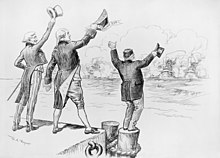
A | B | C | D | E | F | G | H | CH | I | J | K | L | M | N | O | P | Q | R | S | T | U | V | W | X | Y | Z | 0 | 1 | 2 | 3 | 4 | 5 | 6 | 7 | 8 | 9

| ||
|---|---|---|
|
33rd Governor of New York
25th Vice President of the United States
26th President of the United States
First term
Second term
Post Presidency
 |
||
The Great White Fleet was the popular nickname for the group of United States Navy battleships that completed a journey around the globe from December 16, 1907, to February 22, 1909, by order of President Theodore Roosevelt. It consisted of 16 battleships divided into two squadrons, along with various small escorts,[1][2] and earned its moniker for the stark white paint on its hulls.
The fleet's primary mission was to make friendly courtesy visits to numerous countries while displaying new U.S. naval power to the world; Roosevelt sought to demonstrate growing American military prowess and blue-water naval capabilities. Another goal was to deter a threatened war with Japan amid growing tensions around 1907. The voyage helped familiarize the 14,500 officers and sailors with the logistical and planning needs for extended fleet action far from home.
After long neglecting the Navy, Congress started generous appropriations in the late 1880s. Beginning with just 90 small ships, over one-third of them wooden and obsolete, the Navy quickly added new steel fighting vessels. The fleet's capital ships were already obsolete compared to the British dreadnoughts in 1907. Nevertheless, it was by far the largest and most powerful fleet that had ever circled the globe; the mission was a success at home and in every country that was visited, including in Europe (which was visited only briefly).[3]
Background and purpose

United States President Theodore Roosevelt dispatched 16 U.S. Navy battleships of the Atlantic Fleet on a worldwide voyage of circumnavigation from 16 December 1907 to 22 February 1909.[1][2] The hulls were painted white, the Navy's peacetime color scheme, and decorated with gilded scrollwork with a red, white, and blue banner on their bows. The superstructures were painted buff. These ships later came to be known as the Great White Fleet.
The purpose of the fleet deployment was multifaceted. Ostensibly, it served as a showpiece of American goodwill, as the fleet visited numerous countries and harbors. In this, the voyage was not unprecedented. Naval courtesy calls, many times in conjunction with the birthdays of various monarchs and other foreign celebrations, had become common in the 19th century. Port calls showcased pomp, ceremony, and militarism during a period of rising prewar nationalism. In 1891, a large French fleet visited Kronstadt, Russia, in conjunction with negotiations between the two nations. Although France and Russia had been hostile to each other for at least three decades prior, the significance of the call was not lost on Russia, and Tsar Nicholas II signed a treaty of alliance with France in 1894. As navies grew larger, naval pageants grew longer, more elaborate, and more frequent. The United States began participating in these events in 1902, when Roosevelt invited Kaiser Wilhelm II of Germany to send a squadron for a courtesy call to New York City. Invitations for U.S. Navy ships to participate in fleet celebrations in the United Kingdom, France, and Germany followed.[4]
Additionally, the voyage of the Great White Fleet demonstrated both at home and on the world stage that the U.S. had become a major sea power in the years after its triumph in the Spanish–American War, with possessions that included Guam, the Philippines, and Puerto Rico.[5] This was not the first demonstration of U.S. naval power; during the Algeciras Conference in 1906, which was convened to settle a diplomatic crisis between France and Germany over the fate of Morocco, Roosevelt had ordered eight battleships to maintain a presence in the Mediterranean Sea.[6] Since Japan had arisen as a major sea power with the 1905 annihilation of the Russian fleet at Tsushima, the deployment of the Great White Fleet was therefore intended, at least in part, to send a message to Tokyo that the American fleet could be deployed anywhere, even from its Atlantic ports, and would be able to defend American interests in the Philippines and the Pacific.[7][8]
The most serious tensions between the United States and Japan came in 1907, leading to widespread speculation among experts that war was imminent between the two. The main cause was intense Japanese resentment against the mistreatment of Japanese in California. Pulitzer prize-winning biographer Henry Pringle states that sending Great White Fleet so dramatically to Japan in 1908 was, "the direct result of the Japanese trouble."[9] Tensions rapidly de-escalated after the fleet's very friendly reception in Yokohama. Thus, the gesture neutralized the diplomatic trouble that had resulted from anti-Japanese riots in San Francisco. Those problems had been resolved by the Gentlemen's Agreement of 1907 and the fleet visit was a friendly gesture to Japan. The Japanese welcomed it.[10] Roosevelt saw the deployment as one that would encourage patriotism, and give the impression that he would teach Japan "a lesson in polite behavior", as historian Robert A. Hart phrased it.[11] After the fleet had crossed the Pacific, Japanese statesmen realized that the balance of power in the East had changed.[7]
The voyage also provided an opportunity to improve the sea- and battle-worthiness of the fleet. While earlier capital-ship classes such as the Kearsarge, Illinois and Maine were designed primarily for coastal defense, later classes such as the Virginia and Connecticut incorporated lessons learned from the Spanish–American War and were conceived as ships with "the highest practicable speed and the greatest radius of action", in the words of the appropriation bills approved by the United States Congress for their construction. They were intended as modern warships capable of long-range operations. Nevertheless, the experience gained in the recent war with Spain had been limited.[12]
Concerns and preparations
Roosevelt's stated intent was to give the Navy practice in navigation, communication, coal consumption, and fleet maneuvering; Navy professionals maintained, however, that such matters could be served better in home waters. In light of what had happened to the Russian Baltic Fleet, they were concerned about sending their own fleet on a long deployment, especially since part of the intent was to impress a modern, battle-tested navy that had not known defeat. The fleet was untested in making such a voyage, and Tsushima had proven that extended deployments had no place in practical strategy.[13] The Japanese Navy was close to coaling and repair facilities; while American ships could coal in the Philippines, docking facilities were far from optimal. An extended stop on the West Coast of the United States during the voyage for overhaul and refurbishment in dry dock would be a necessity. Planning for the voyage, however, showed a dearth of adequate facilities there, as well. The main sea channel of the Mare Island Naval Shipyard near San Francisco was too shallow for battleships, which left only the Puget Sound Navy Yard in Bremerton, Washington, for refit and repair. The Hunter's Point civilian yard in San Francisco could accommodate capital ships, but had been closed due to lack of use and was slated for demolition. President Roosevelt ordered that Hunter's Point be reopened, facilities be brought up to date, and the fleet to report there.[14]
Also, the question of adequate resources for coaling existed. This was not an issue when the Atlantic Fleet cruised the Atlantic or Caribbean, as fuel supplies were readily available. However, the United States did not enjoy a worldwide network of coaling stations like that of Great Britain, nor did it have an adequate supply of auxiliary vessels for resupply. During the Spanish–American War, this lack had forced Admiral George Dewey to buy a collier-load of British coal in Hong Kong before the Battle of Manila Bay to ensure his squadron would not run out of steam at sea. The need had been even more pressing for the Russian Baltic Fleet during its long deployment during the Russo-Japanese War, not just for the distance it was to steam, but also because, as a belligerent nation in wartime, most neutral ports were closed to it due to international law. While the lack of support vessels was pointed out and a vigorous program of building such ships suggested by Rear Admiral George W. Melville, who had served as chief of the Bureau of Equipment, his words were not heeded adequately until World War II.[15]
Federal regulations that restricted supply vessels for Navy ships to those flying the United States flag, complicated by the lack of an adequate United States Merchant Marine, proved another obstacle. Roosevelt initially offered to award Navy supply contracts to American skippers whose bids exceeded those of foreign captains by less than 50%.[16] Many carriers declined this offer because they could not obtain enough cargo to cover the cost of the return trip. Two months before the fleet sailed, Roosevelt ordered the Navy Department to contract 38 ships to supply the fleet with the 125,000 tons of coal it would need to steam from Hampton Roads, Virginia, to San Francisco. Only eight of these were American-registered; most of the other 30 were of British registry. This development was potentially awkward, since part of the mission was to impress Japan with the perception of overwhelming American naval power. Britain had become a military ally of Japan in 1902 with the Anglo-Japanese Alliance, which obliged it to aid Japan should a foreign power declare war against it. Technically, the list of potential combatants included the United States. The British government decided to play both sides of the political fence with the intent of moderating any Japanese-American friction that might arise.[17]
Prior to the ships’ departure, Congress raised concerns about funding. According to the Naval Historical Center, Maine Senator Eugene Hale made his intention known to withhold funding for the effort. The President's response was that if Congress was unwilling to fund the trip, he already had the funds to send the fleet out into the Pacific.[18] If Congress wanted the fleet to return home, though, they would have to fund the other half of the trip.[19] As noted by Roosevelt biographer Edmund Morris, the President would not be deterred. He stated "I am Commander-in-Chief, and my decision is absolute in the matter."[20]
Voyage



As the Panama Canal was not yet complete, the fleet had to pass through the Straits of Magellan. The scope of such an operation was unprecedented in U.S. history, as ships had to sail from all points of the compass to rendezvous points and proceed according to a carefully orchestrated, well-conceived plan.[1] It involved almost the entire operational capability of the U.S. Navy. During the crossing of the Straits of Magellan, the U.S. ships were escorted by the Chilean Navy cruiser, Chacabuco.[21]
Unlike the formidable obstacles that had faced the Russian fleet[nb 1] on its voyage from the Baltic to the Pacific, which eventually led to its destruction by the Japanese in 1905,[22][23] the U.S. effort benefited from a peaceful environment, which aided the coordination of ship movements.
After taking nearly four months to round South America, the fleet made several stops in American waters on the Pacific Ocean. In port after port, thousands of citizens turned out to see and greet the fleet. In April 1908, 16 battleships anchored off of Coronado, California, in the San Diego area, and thousands of sailors and marines took part in a parade through San Diego's streets.[24] The fleet also stopped in Los Angeles and Santa Barbara. In May 1908, the fleet visited Monterey, California; the nearby Hotel Del Monte in Del Monte, California, hosted a grand ball for the officers of the fleet. After arriving in San Francisco on 6 May, most of the fleet took a side trip to Seattle and Tacoma, then returned to San Francisco.[25][26]
On 7 July, the entire fleet left San Francisco for Honolulu, New Zealand, and Australia. In Australia, the arrival of the Great White Fleet on 20 August 1908 was used to encourage support for the forming of Australia's own navy.[27] In Sicily, sailors helped in recovery operations after the 1908 Messina earthquake.[28]
Fleet composition
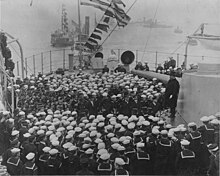
The 14-month-long voyage was intended to be a grand pageant of American naval power. The squadrons were manned by 14,000 sailors. They covered some 43,000 nautical miles (80,000 km) and made 20 port calls on six continents.[1] The fleet was impressive, especially as a demonstration of American industrial prowess (all 18 ships had been constructed since the Spanish–American War), but already the battleships represented the suddenly outdated predreadnought type of capital ship, as the first battleships of the revolutionary Dreadnought class had just entered service, and the U.S. Navy's first dreadnought, South Carolina, was already fitting out. The two oldest ships in the fleet, Kearsarge and Kentucky, were already obsolete and unfit for battle; two others, Maine and Alabama, had to be detached at San Francisco because of mechanical troubles and were replaced by the Nebraska and the Wisconsin. After repairs, Alabama and Maine completed their "own, more direct, circumnavigation of the globe" via Honolulu, Guam, Manila, Singapore, Colombo, Suez, Naples, Gibraltar, the Azores, and finally back to the United States, arriving on 20 October 1908, four months before the remainder of the fleet, which had taken a more circuitous route.[29][30]
The battleships were accompanied during the first leg of their voyage by a "Torpedo Flotilla" of six early destroyers, and by several auxiliary ships. The destroyers and their tender did not actually steam in company with the battleships, but followed their own itinerary from Hampton Roads to San Francisco, California.[1] Also, the armored cruiser Washington preceded the fleet itinerary for its first and second legs by about a month, perhaps making arrangements to later receive the fleet.[31]
General fleet itinerary
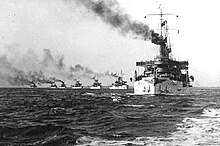


With Connecticut[33] as flagship under the command of Rear Admiral Robley D. Evans, the fleet sailed from Hampton Roads on 16 December 1907 for Trinidad, British West Indies, thence to Rio de Janeiro, Brazil; Punta Arenas, Chile; Callao, Peru; Magdalena Bay, Mexico, and north along the West Coast, arriving at San Francisco on 6 May 1908.[34]
At San Francisco, Rear Admiral Charles S. Sperry assumed command of the fleet, owing to the poor health of Admiral Evans. Also at San Francisco, the squadrons were slightly rearranged, bringing the newest and best ships in the fleet up to the First Squadron. Glacier was detached and later became the supply ship of the Pacific Fleet. At this time also, Nebraska, under Captain Reginald F. Nicholson, and Wisconsin, under Captain Frank E. Beatty, were substituted for Maine and Alabama. In San Francisco, Minnesota was brought forward into First Squadron, First Division, and Louisiana took her place as flagship, Second Squadron.
Leaving that port on 7 July 1908 the U.S. Atlantic Fleet visited Honolulu; Auckland, New Zealand; Sydney, Melbourne, and Albany, Australia; Manila, Philippines; Yokohama, Japan; and Colombo, Ceylon; then arriving at Suez, Egypt, on 3 January 1909.
While the fleet was in Egypt, word was received of an earthquake in Sicily, thus affording an opportunity for the United States to show its friendship to Italy by offering aid to its victims. Connecticut, Illinois, Culgoa, and Yankton were dispatched to Messina, Italy, at once. The crew of Illinois recovered the bodies of the American consul, Arthur S. Cheney, and his wife, entombed in the ruins. Scorpion, the fleet's station ship at Constantinople, and Celtic, a refrigerator ship fitted out in New York, were hurried to Messina, relieving Connecticut and Illinois, so that they could continue on the cruise.[28]
Leaving Messina on 9 January 1909, the fleet stopped at Naples, Italy,[citation needed] thence to Gibraltar, arriving at Hampton Roads on 22 February 1909. There, President Roosevelt reviewed the fleet as it passed into the roadstead.[34]
First leg
From Hampton Roads to San Francisco, 14,556 nautical miles (26,958 km).[34]
Itinerary
| Port | Arrival | Departure | Distance to next port |
|---|---|---|---|
| Hampton Roads, Virginia | 16 December 1907 | 1,803 nmi (3,339 km) | |
| Port of Spain, Trinidad | 23 December 1907 | 29 December 1907 | 3,399 nmi (6,295 km) |
| Rio de Janeiro, Brazil | 12 January 1908 | 21 January 1908 | 2,374 nmi (4,397 km) |
| Punta Arenas, Chile | 1 February 1908 | 7 February 1908 | 2,838 nmi (5,256 km) |
| Callao, Peru | 20 February 1908 | 29 February 1908 | 3,010 nmi (5,570 km) |
| Magdalena Bay, Mexico | 12 March 1908 | 11 April 1908 | 1,132 nmi (2,096 km) |
| San Francisco, California | 6 May 1908 |
Ships
The Fleet, First Squadron and First Division, were commanded by Rear Admiral Robley D. Evans.[35] First Division consisted of four ships of the 1906 Connecticut class: Connecticut, the fleet's flagship, Captain Hugo Osterhaus; Kansas, Captain Charles E. Vreeland; Vermont, Captain William P. Potter; and Louisiana, Captain Richard Wainwright.
Second Division was commanded by Rear Admiral William H. Emory. Second Division consisted of four ships of the 1904 Virginia class: Georgia, the division flagship, Captain Henry McCrea; New Jersey, Captain William H. H. Southerland; Rhode Island, Captain Joseph B. Murdock; and Virginia, Captain Seaton Schroeder.
Second Squadron and Third Division were commanded by Rear Admiral Charles M. Thomas. Third Division consisted of one Connecticut-class ship and the three ships of the 1902 Maine class: Minnesota, the squadron flagship, Captain John Hubbard; Maine, Captain Giles B. Harber; Missouri, Captain Greenlief A. Merriam; and Ohio, Captain Charles W. Bartlett.
Fourth Division was commanded by Rear Admiral Charles S. Sperry. Fourth Division consisted of two ships of the 1901 Illinois class and the two 1900 Kearsarge class ships: Alabama, the division flagship, Captain Ten Eyck De Witt Veeder; Illinois, Captain John M. Bowyer, Kearsarge, Captain Hamilton Hutchins; and Kentucky, Captain Walter C. Cowles.
The fleet auxiliaries consisted of Culgoa (a storeship), Lieutenant Commander John B. Patton; Glacier (a storeship), Commander William S. Hogg; Panther (a repair ship), Commander Valentine S. Nelson; Yankton (a tender), Lieutenant Walter R. Gherardi; and Relief (a hospital ship).
The "Torpedo Flotilla" of destroyers consisted of Hopkins, Lieutenant Alfred G. Howe; Stewart, Lieutenant Julius F. Hellweg; Hull, Lieutenant Frank McCommon; Truxton, Lieutenant Charles S. Kerrick; Lawrence, Lieutenant Ernest Friedrick; Whipple, Lieutenant Hutch I. Cone; and Arethusa (a tender), Commander Albert W. Grant.
Second leg
Itinerary
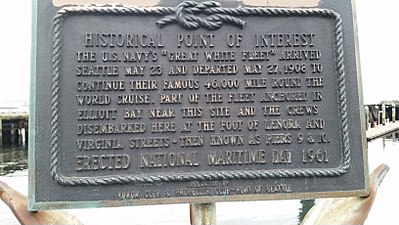


The second leg of the voyage was from San Francisco to Puget Sound and back. On 23 May 1908 the 16 battleships of the Great White Fleet steamed into Puget Sound where they separated to visit six Washington state ports: Bellingham, Bremerton, Port Angeles, Port Townsend, Seattle and Tacoma.[36] The fleet arrived in Seattle on 23 May and departed 27 May 1908.[37]
Ships
The Fleet, First Squadron, and First Division were commanded by Rear Admiral Charles S. Sperry.[35] First Division consisted of Connecticut, the Fleet's flagship, Captain Hugo Osterhaus; Kansas, Captain Charles E. Vreeland; Minnesota, Captain John Hubbard; and Vermont, Captain William P. Potter.
Second Division was commanded by Rear Admiral Richard Wainwright. Second Division consisted of Georgia, the Division flagship, Captain Edward F. Qualtrough; Nebraska, Captain Reginald F. Nicholson, replacing her sister Virginia; New Jersey, Captain William H.H. Southerland; and Rhode Island, Captain Joseph B. Murdock.
Second Squadron and Third Division were commanded by Rear Admiral William H. Emory. Third Division consisted of Louisiana, the Squadron's flagship, Captain Kossuth Niles; Virginia, Captain Alexander Sharp; Missouri, Captain Robert M. Doyle; and Ohio, Captain Thomas B. Howard.
Fourth Division was commanded by Rear Admiral Seaton Schroeder. Fourth Division consisted of Wisconsin, the Division flagship, Captain Frank E. Beatty, which replaced her sister Alabama; Illinois, Captain John M. Bowyer; Kearsarge, Captain Hamilton Hutchins; and Kentucky, Captain Walter C. Cowles.
The Fleet Auxiliaries were Culgoa (a storeship), Lieutenant Commander John B. Patton; Yankton (a tender), Lieutenant Commander Charles B. McVay; Glacier (a storeship), Commander William S. Hogg; Relief (a hospital ship), Surgeon Charles F. Stokes; and Panther (a repair ship), Commander Valentine S. Nelson.
Third leg
From San Francisco to Manila, 16,336 nautical miles (30,254 km).[35]
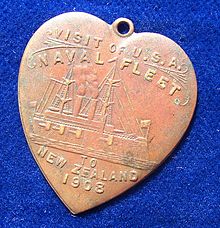
Itinerary
| Port | Arrival | Departure | Distance to next port |
|---|---|---|---|
| San Francisco, California | 7 July 1908 | 2,126 nmi (3,937 km) | |
| Honolulu, Hawaii | 16 July 1908 | 22 July 1908 | 3,870 nmi (7,170 km) |
| Auckland, New Zealand | 9 August 1908 | 15 August 1908 | 1,307 nmi (2,421 km) |
| Sydney, New South Wales, Australia | 20 August 1908 | 28 August 1908 | 601 nmi (1,113 km) |
| Melbourne, Victoria, Australia | 29 August 1908 | 5 September 1908 | 1,368 nmi (2,534 km) |
| Albany, Western Australia, Australia | 11 September 1908 | 18 September 1908 | 3,458 nmi (6,404 km) |
| Manila, Philippines | 2 October 1908 | 9 October 1908 | 1,795 nmi (3,324 km) |
| Yokohama, Japan | 18 October 1908 | 25 October 1908 | 1,811 nmi (3,354 km) |
| Amoy, China (Second Squadron) |
29 October 1908 | 5 November 1908 | |
| Manila, Philippines (First Squadron) |
31 October 1908 | ||
| Manila, Philippines (Second Squadron) |
7 November 1908 |
Ships
The Fleet, First Squadron, and First Division were commanded by Rear Admiral Charles S. Sperry. First Division consisted of Connecticut, the Fleet's flagship, Captain Hugo Osterhaus; Kansas, Captain Charles E. Vreeland; Minnesota, Captain John Hubbard; and Vermont, Captain William P. Potter.
Second Division consisted of Georgia, the Division flagship, Captain Edward F. Qualtrough; Nebraska, Captain Reginald F. Nicholson; New Jersey, Captain William H.H. Southerland; and Rhode Island, Captain Joseph B. Murdock.
The Second Squadron and Third Division were commanded by Rear Admiral William H. Emory. Third Division consisted of Louisiana, the Squadron flagship, Captain Kossuth Niles; Virginia, Captain Alexander Sharp; Missouri, Captain Robert M. Doyle; and Ohio, Captain Thomas B. Howard.
Fourth Division was commanded by Rear Admiral Seaton Schroeder. Fourth Division consisted of Wisconsin, the Division flagship, Captain Frank E. Beatty; Illinois, Captain John M. Bowyer; Kearsarge, Captain Hamilton Hutchins; and Kentucky, Captain Walter C. Cowles.
The Fleet Auxiliaries were Culgoa (a storeship), Lieutenant Commander John B. Patton; Yankton (a tender), Lieutenant Commander Charles B. McVay; Glacier (a storeship), Commander William S. Hogg; Relief (a hospital ship), Surgeon Charles F. Stokes; and Panther (a repair ship), Commander Valentine S. Nelson.
Final leg
The final leg ran from Manila to Hampton Roads, 12,455 nautical miles (23,067 km).[35]
Itinerary
